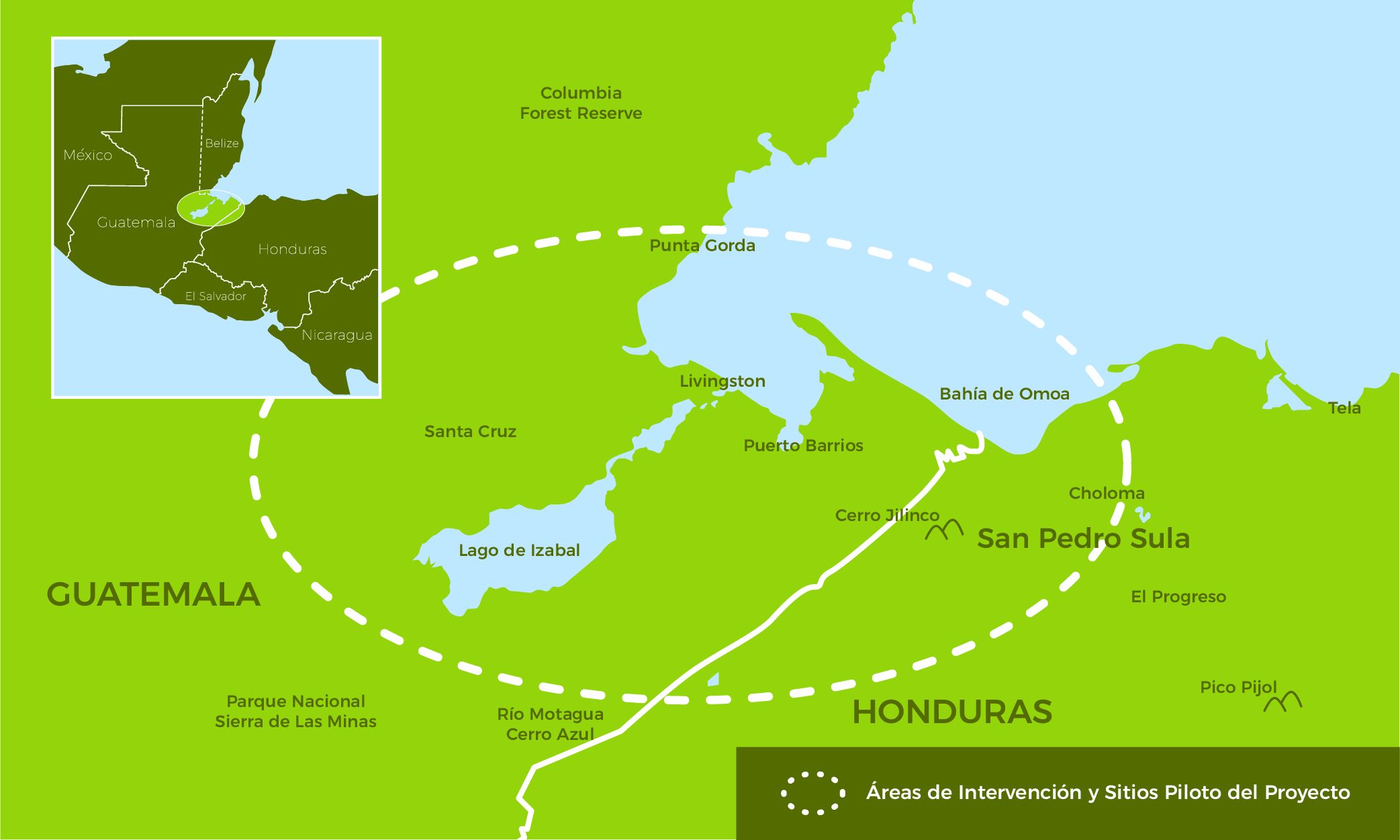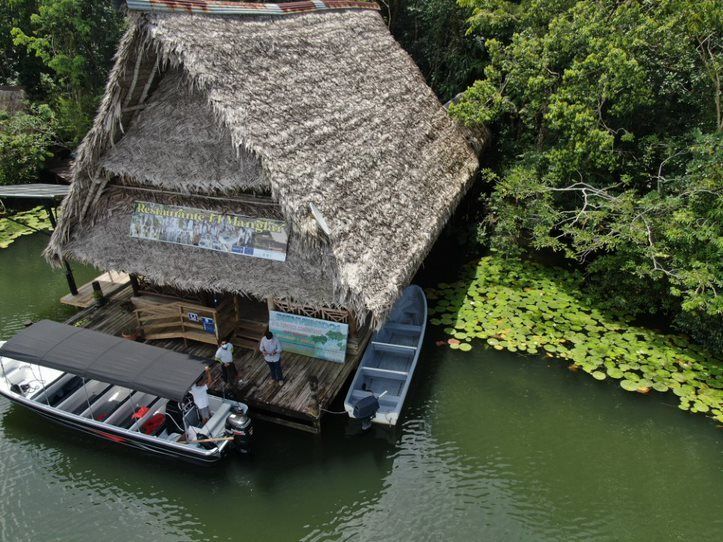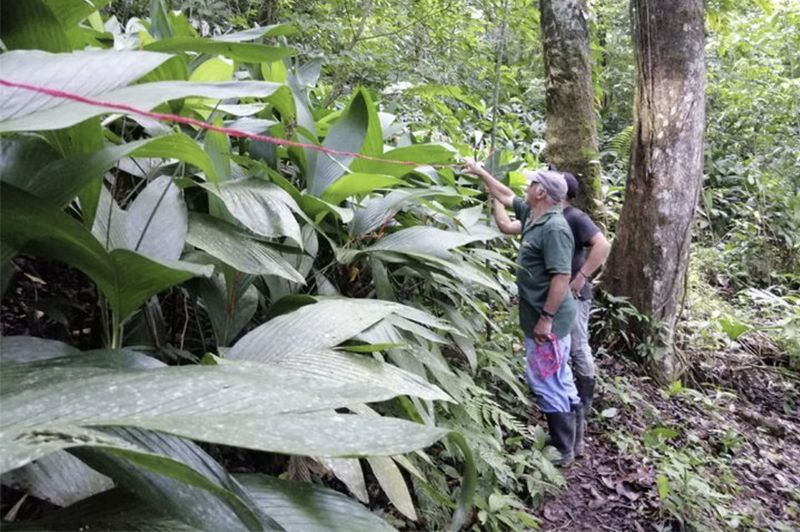The Forests, Biodiversity and Community Development project promoted the creation and development of the biological corridor, which benefits more than 6000 inhabitants in the two countries.
Guatemala, November 2021. The protected areas Manabique Point Wildlife Refuge in Guatemala, Cuyamel Wildlife Refuge and Omoa National Park located in Honduras, are part of a transboundary zone covering an area of 55,441.35 hectares of subtropical rainforest. Due to their location, the area contributes to climate action through nature, through the conservation of reef areas, seagrasses, subtropical forests, mangroves and beaches. These natural areas are important for the conservation of more than 300 bird species including the endangered yellow-headed parrot. There are also animals such as jaguars, manatees and the green iguana; and more than 160 species of plants.
This border area is also home to 6,000 people from the Ladino, Maya Quekchí and Garífuna ethnic groups, who promote the preservation of the territory, especially through community tourism and reforestation activities, as well as the conservation and transmission of traditional knowledge about agriculture and the use of medicinal plants.
| Find out where the project is located in Guatemala and Honduras |
 |
Despite the extraordinary biodiversity, this frontier faces problems related to climate change such as reduced water availability and quality, displacement of pests, increased forest fires due to droughts, among others.
A sustainable biological corridor to tackle climate change and protect biodiversity
In this context, the "Forests, Biodiversity and Community Development" project of the EUROCLIMA+ programme, led by the International Committee for the Development of Peoples (Comitato Internazionale per lo Sviluppo dei Popoli-CISP), has been developing various actions since 2019 to create the Cuyamel - Omoa Punta de Manabique Sustainable Biological Corridor, which is a place of great biological interconnectivity and which strengthens the protection of ecosystem services and populations.
The project's initiatives, through the support and strengthening of the creation of the Corridor, have enabled the reforestation and restoration of landscapes in 9 communities, with 166.6 hectares of protected tropical forest planted with xate, red and white mangroves and mixed species; and 14 hectares restored with red mangrove, white mangrove, royal palm and cahué. We have also supported the prevention of illegal extraction of species, generating economic incentive projects, awareness-raising actions and community development. In addition, governance has been strengthened by establishing alliances with key actors from governmental, municipal and local institutions, and integrating members of the beneficiary communities, thus establishing a participatory process.
Prioritising the consolidation of the biological corridor, a management group has been created that brings together different actors for the benefit of the area and the populations. This group is made up of representatives of Civil Society Organisations ( OBC, NGOs), academia, community representatives and governmental entities from both countries, with the aim of following up on the actions established in the CBS Strategic Plan, which was developed for a five-year period (2020 - 2025).
Gustavo Cabrera, director of the Omoa Conservation Corps Association (CCO) of Honduras, explains how the proposal for the creation of the corridor has allowed the creation of instruments, strategic plans and economic valuation studies of the ecosystem goods and services offered by the natural space
Reforestation with mangroves to protect against storms and hurricanes
According to the "Multi-temporal analysis study of the mangrove ecosystem in the protected areas of La Graciosa Bay of the Manabique Point Wildlife Refuge" developed by the project, for the last decade the area of the corridor has been vulnerable to the presence of storms and hurricanes that are intensifying due to climate change.
In view of this evidence, through an articulated process led by the project, a series of actions were developed that have allowed the reforestation of the proposed Biological Corridor area with mangrove and other native species, such as the royal palm, which allows the conservation of the yellow-headed parrot. The mangrove represents a valuable breeding habitat for fish and crustaceans, where they also lay eggs and provide a resting place for a large number of birds. Reptiles and amphibians take refuge in the roots of this species; its structure represents a barrier that diminishes the effect of storms and hurricanes; and the carbon sequestration of mangrove forests is double that of terrestrial forests.
For this reason, mangrove nurseries have been created and communities have been trained in the management, planting and conservation of this species. Information has also been disseminated on the importance of sustainable and moderate fishing. By the end of the project, approximately 30 hectares of mangrove are expected to be reforested in the proposed corridor.
Pabla Rivera, from the Barra de Montagua community (Honduras) and a beneficiary of the project, says that the hurricanes are generally having a stronger impact on the community and causing problems in the homes. In this video, Pabla points out that through the protection and reforestation of the mangroves, these effects have been reduced, and in turn, through the training provided by the project, the communities have become aware of the importance of protecting the mangroves.
Tourism ventures linked to the corridor
The consequences of hurricanes Eta and Iota, and the COVID-19 pandemic, significantly affected the tourism sector. For this reason, initiatives have been carried out to strengthen the reactivation of community tourism through promotional activities, training and regional workshops for the exchange of experiences; and support to obtaining the biosecurity seal granted by the Guatemalan Tourism Institute (INGUAT) and thus accelerate economic reactivation.
Tourism ventures such as Café Tatín, the Buga Mama Restaurant, both of the Ak'tenamit Association, and the El Manglar Restaurant of the Women's Committee of the Cayo Quemado village in Livingston, Izabal, obtained the biosecurity seal, awarded by the Guatemalan Tourism Institute (INGUAT) and the international Safe Travels seal, which provides more opportunities to attract tourism to the area.
 |
| Tourism ventures drive protection of the sustainable biological corridor |
Some of these companies are also beneficiaries of the "Small Grants" mechanism, an initiative set up by the project, which has enabled Local Grassroots Organisations (LBOs) to implement sustainable development initiatives and play an active role in decision-making related to environmental protection, take responsibility for the management of public funds and improve their living conditions, generating sustainable social and economic development that is compatible with natural spaces.
Community exchange and learning
One of the most important axes of the project, which has allowed it to achieve its objectives, was to have the Association for Local Environmental Management Programmes (Spanish acronym ASOPROGAL) in Guatemala and the Conservation Corps of Omoa (CCO) in Honduras as project partners.
Mishel Cardona, technical specialist at ASOPROGAL, argues that community participation has been central to the project as villagers know how to protect the protected areas.
Hendrick Acevedo, coordinator of the Manabique Point protected area of Guatemala's National Council of Protected Areas (CONAP), adds that empowering the communities has been a strengthening process. The exchange of knowledge between technicians and leaders has allowed them to enhance the actions for the sustainability of the project.
Replicability beyond borders
The project's actions are also presented as tools for strengthening processes that contribute to enhancing the natural, social and human capital of the territory, as well as being part of the concrete actions that operationalise the public policies of each country.
In fact, sustainability and monitoring of actions are some of the main focuses, which is why relationships have been initiated and strengthened with different institutions, which have joined forces to promote the conservation and protection of the protected areas.
Daniel Gallegos, director of the project, argues that it is important to have a vision of the territory beyond the borders.
“We are articulating the climate commitments (NDCs) of Guatemala and Honduras, and we are focusing directly on climate change adaptation measures. Working with different actors strengthens the vision of the territory that goes beyond the borders. Ecosystems, biodiversity and forests require actions that do not end at a border, so we are thinking together because what we do in one country will have repercussions in the other.”
Alberto Cortezón, Head of Cooperation of the European Union Delegation in Guatemala, highlighted several actions developed by the project.
“The project has managed to create a space for dialogue among the different actors: at the institutional level, with the communities, civil society, and even the private sector. We are talking about environmental protection, the fight against climate change, which is a very complex issue and therefore requires the commitment and effort of all the actors on the ground.”
The different initiatives can be replicated in other border areas of the region, such as Honduras and El Salvador or Guatemala and Mexico, allowing for the conservation of species and the sustainable development of communities. The process of establishing the biological corridor, mangrove reforestation, support for tourism ventures, small donations, studies and plans are some of the actions that can be replicated on the borders and in protected areas that have similar characteristics and allow for the preservation of ecosystems for climate action.
Data
- The Forests, Biodiversity and Community Development project is part of the "Forests, Biodiversity and Ecosystems" sector of the EUROCLIMA+ programme, implemented by the agencies Expertise France (EF) and the German Society for International Cooperation (GIZ) GmbH. Find out more here.
- The project has been led by CISP together with its local and national partners: the Association of Local Environmental Management Programmes (ASOPROGAL), the National Council of Protected Areas (CONAP) in Guatemala, and the Omoa Conservation Corps (CCO) and the Institute of Forest Conservation (ICF) in Honduras.
Studies carried out
Studies produced by the project include:
Articles about the project
- Reforestation of mangrove forests helps fishermen of Izabal in Guatemala
- Guatemala and Honduras promote sustainable community-based tourism activities
Communities of the Maya Biosphere Reserve learn how to develop forest management plans and enterprises - Seven community projects in Guatemala receive financial support
About EUROCLIMA+
EUROCLIMA+ is a programme funded by the European Union and co-financed by the German federal government through the Federal Ministry for Economic Cooperation and Development (BMZ), as well as by the governments of France and Spain through the Ministry of Foreign Affairs, European Union and Cooperation.
The Programme's mission is to reduce the impact of climate change and its effects in 18 countries of Latin America and the Caribbean, promoting mitigation, adaptation, resilience and climate investment. It is implemented according to the "Spirit of Team Europe" under the synergistic work of seven agencies: the Spanish Agency for International Development Cooperation (AECID), the French Development Agency (AFD), the Economic Commission for Latin America and the Caribbean (ECLAC), Expertise France (EF), the International and Ibero-America Foundation for Administration and Public Policy (FIIAPP), the German Society for International Cooperation (GIZ) GmbH, and the UN Environment Programme (UNEP).
Contact for more information: This email address is being protected from spambots. You need JavaScript enabled to view it.




